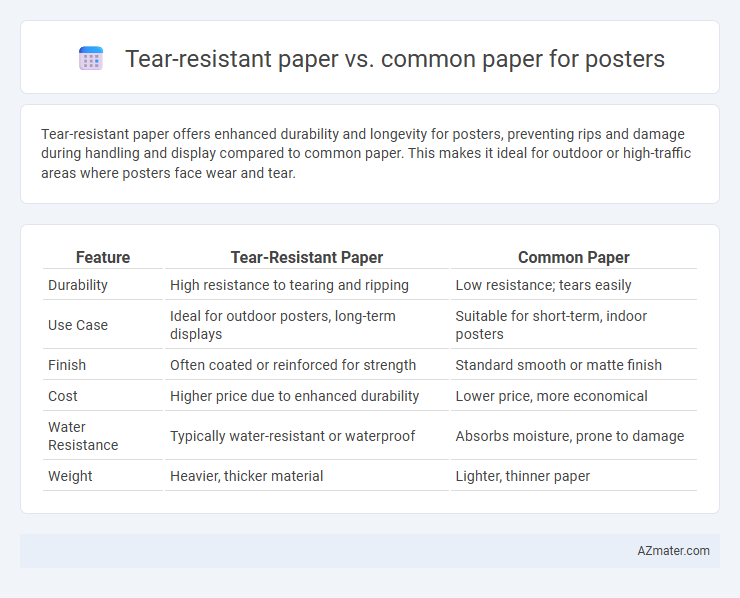Tear-resistant paper offers enhanced durability and longevity for posters, preventing rips and damage during handling and display compared to common paper. This makes it ideal for outdoor or high-traffic areas where posters face wear and tear.
Table of Comparison
| Feature | Tear-Resistant Paper | Common Paper |
|---|---|---|
| Durability | High resistance to tearing and ripping | Low resistance; tears easily |
| Use Case | Ideal for outdoor posters, long-term displays | Suitable for short-term, indoor posters |
| Finish | Often coated or reinforced for strength | Standard smooth or matte finish |
| Cost | Higher price due to enhanced durability | Lower price, more economical |
| Water Resistance | Typically water-resistant or waterproof | Absorbs moisture, prone to damage |
| Weight | Heavier, thicker material | Lighter, thinner paper |
Introduction: Importance of Paper Choice for Posters
Choosing tear-resistant paper for posters significantly enhances durability and longevity compared to common paper, which is prone to damage during handling and display. Tear-resistant paper contains reinforced fibers or synthetic blends that resist ripping, making it ideal for high-traffic areas and long-term use. Selecting the right paper ensures posters maintain visual appeal and structural integrity, crucial for effective communication and promotional impact.
What is Tear-Resistant Paper?
Tear-resistant paper is a specially engineered material designed to withstand ripping and puncturing, making it ideal for posters intended for long-term display or outdoor use. Unlike common paper, which easily tears under stress, tear-resistant paper incorporates synthetic fibers or polymer coatings to enhance durability and maintain visual integrity. Its robust composition ensures that posters remain intact and readable even in harsh environmental conditions, outperforming standard paper in resilience and lifespan.
Characteristics of Common Poster Paper
Common poster paper typically features a lightweight, smooth surface that allows for vibrant ink absorption but lacks durability against tearing. Its standard fiber composition makes it prone to damage from moisture, bending, and rough handling, limiting its lifespan in outdoor or high-traffic environments. Cost-effective and widely available, common paper suits short-term displays but falls short in resistance compared to tear-resistant alternatives designed with reinforced fibers or synthetic blends.
Durability: Comparing Tear-Resistant vs Common Paper
Tear-resistant paper offers superior durability compared to common paper, making it ideal for posters exposed to frequent handling or outdoor conditions. This paper type resists rips and tears due to its reinforced fibers, extending the lifespan of posters significantly. In contrast, common paper is prone to damage from moisture, folding, and accidental tearing, reducing the overall durability and visual appeal of posters over time.
Print Quality and Color Vibrancy
Tear-resistant paper offers superior print quality for posters, maintaining sharp details and crisp text without smudging or fading over time. Its specialized coating enhances color vibrancy, producing rich, vivid hues that outperform common paper, which often yields duller colors and less definition. The durability of tear-resistant paper also prevents damage from handling, preserving the poster's visual impact longer than standard paper options.
Weather and Environmental Resistance
Tear-resistant paper offers superior durability compared to common paper, making it ideal for posters exposed to harsh weather conditions such as rain, wind, and sunlight. Its enhanced environmental resistance includes water-repellent coatings and reinforced fibers, preventing damage from moisture and UV rays that typically degrade common paper quickly. This makes tear-resistant paper a more reliable choice for long-lasting outdoor posters and signage.
Cost Analysis: Investment vs Longevity
Tear-resistant paper for posters commands a higher upfront cost compared to common paper but offers superior durability, reducing replacement expenses over time. Its enhanced longevity minimizes wear and damage from handling and environmental factors, making it a cost-effective investment for long-term displays. Choosing tear-resistant paper ultimately lowers cumulative costs by extending the lifespan of posters in high-traffic or outdoor settings.
Eco-Friendliness and Sustainability
Tear-resistant paper for posters offers enhanced durability, reducing the need for frequent replacements and minimizing paper waste compared to common paper varieties. This durability supports eco-friendliness by conserving resources and lowering landfill contributions, while many tear-resistant papers are also recyclable or made from recycled materials. Common paper, often less durable, generates more waste and environmental strain due to its shorter lifespan and increased consumption.
Best Use Cases for Tear-Resistant Paper
Tear-resistant paper offers superior durability and resistance to damage, making it ideal for outdoor posters, event signage, and high-traffic areas where exposure to wind, moisture, and handling is common. Unlike common paper, which easily tears and deteriorates, tear-resistant options maintain visual integrity and vibrancy over extended periods. This makes tear-resistant paper the best choice for long-term displays, promotional materials, and environments requiring robust print media performance.
Conclusion: Making the Right Choice for Your Poster
Tear-resistant paper offers superior durability and longevity compared to common paper, making it ideal for posters displayed in high-traffic or outdoor environments. Common paper is more cost-effective but less resistant to damage from handling and weather conditions. Selecting tear-resistant paper ensures the poster maintains its quality and appearance over time, justifying the higher investment for important or long-term displays.

Infographic: Tear-resistant paper vs Common paper for Poster
 azmater.com
azmater.com